The present article consists in a brief outlook of the nature of the diverse educational systems either in the rising and falling imperial realms or in the chaotic and worthless republics that lack sanctity, legitimacy, and humanity. Here you will find its first part.
I. Education, Social Unity, and Transcendence in the Ancient Oriental Empires
In ancient times, Education was at the hands of the spiritual-sacerdotal-imperial savants and the instructors did their ingenious best to educate their pupils by making them fully aware of the Laws of the spiritual and the material universes, which were also reflected in the average culture of all the inhabitants of the ideal, paradisiacal empire that mirrored the celestial world on the surface of the Earth. There was absolutely no disconnection between the educated and the uneducated, because the latter comprehended in general -via mythical, cultural, education- what the former mastered in detail through systematic scientific exploration, archiving and education.
This was how the emerged great kingdoms and formidable empires were structured in Mesopotamia (Sumer, Akkad, Assyria-Babylonia, Hurrians, and Elam), Kemet (Egypt), Hittite Anatolia, Cush (Ancient Sudan), Phoenicia-Carthage, Iran and Turan, China, and Indus Valley and the Deccan. There was Unity in Education, as all the people understood the supreme language of the Myth and the Symbols that exist between the spiritual and the material universes, and as a consequence, they all had the same world view, the same spirituality and culture, and the same moral standards, which defined the sanctity of their empire.



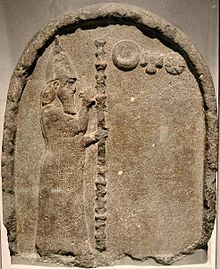

II. Lack of Sacerdotal and Imperial Authority in the Low Educational Systems of the Ancient Greek and Roman Barbarians
Ancient Greece and Rome, as small, divided and unsophisticated local societies, were ignorant, barbaric and marginal lands as regards the Ancient Oriental empires; there was no spirituality, no imperial tradition, no sacerdotal scholarship, and no unity of Education. There was division in society, disunity among the various tribes, and clash among the various philosophers who were educated not locally but in the great temples of Egypt, Phoenicia, Babylonia, and Iran. Ancient Greek religion was a petty version, a miserable imitation, and a pale reflection of the Ancient Oriental religions.
There was no transcendence, no contemplation, no meditation, and no sanctity in Ancient Greece; the gods of the Ancient Greeks were mere human projections onto the spiritual world, and as such they were inferior to the aspects of the Divine World, which formed the fundamental truths of the archetypal Oriental myths. Lacking spiritual authority, scientific knowledge, and moral wisdom, the Ancient Greeks became mere ‘friends of the wisdom’, which is the real meaning of the Ancient Greek word ‘philosopher’. In their otherwise worthless education, they replaced the transcendental truth with useless verbosity, the mythical symbolism with puerile anthropomorphism, the sacrosanct theatrical events with their debased public theater, and the Imperial Paradise with their Civil War.


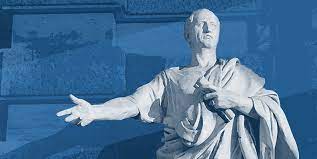
III. Education and Culture in Imperial Rome: Result of an Overwhelming Orientalization
Rome became an Empire very late, and achieved a level of Orientalization too late. As a matter of fact, there was no unity in education, and consequently, there was a total disconnection between the educated and the uneducated. This is said with respect to the Romans themselves, the citizens of Rome during the times of the Res Publica (‘Republic’: 510-27 BCE). This phenomenon was the result of the formation of an elite/elitist class with increased focus on material interests, lower degree of piety, and total lack of imperial world view and tradition.
When people deliberate in public, the focus is shifted away from spirituality, moral standards, and culture to petty personal interests and elite privileges. Then, few representatives can take decisions on common issues, discord and disunity appear only to prevail across the society, while social class divisions become the reason of endless strife; the ensuing social stratification destroys or prevents unity in culture and education.
This situation became very ostensible in the early Roman imperial times, when the elite continued living influenced by the Ancient Greek social lifestyle, involving theater, philosophy, and public debates (as the Senatus had still some power), but the Romans, i.e. the average people in their outright majority, had already accepted different Oriental cults, mysteries, religions, schools of spirituality, oracles, mythical symbolisms, and dogmas of cosmogony, cosmology, apocalyptic eschatology and soteriology.
It was only normal for the old republican traditions and the useless public debates to be soon swept away by the mysteries of Mithras, Zurvan-Saturn, Isis, Horus, Osiris, Sarapis, Anubis, Sabazios, Elagabalus, Cybele, Attis, and other Oriental cults and mystical systems (Chaldeanism, Ostanism, Gnosticisms, Hermetism) to which almost all the Romans gradually adhered, abandoning their impotent ancestral divinities and seeking salvation in the dogmas of the Chaldean Aramaeans, the Egyptians, the Cushites, the Anatolians, and the Iranians.


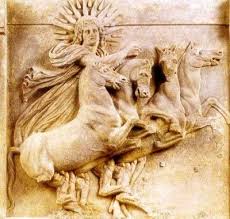
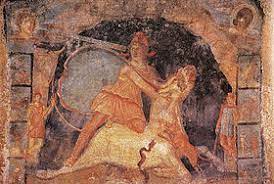
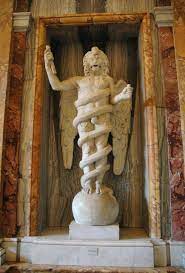

There was a major difference between Trajan’s Rome from one side and from the other side Darius I the Great’s Iran, Sargon II’s Assyria, Thutmose III’s Egypt, Mursilis I’s Hittite Anatolia, Hammurapi’s Babylonia, Urukagina’s Sumer (Lagash and Girsu), and Sargon I’s Akkad: different cultural and educational systems existed across the Roman Empire at the time of its greatest expansion. I don’t mean this in terms of regional differentiation in culture and education among the various nations that lived in Anatolia, Egypt, Carthage, Numidia, Gaul and other provinces. I refer to the still existing differentiation between Roman elite culture, world view, and education from one side and from the other side the popular culture, world view, and education across the empire.
However, it was only a matter of time, and finally, the culture, the world view, and the education of the average people prevailed; they were finally imposed on the Roman elite; during the 3rd c. CE, Rome looked very much like an Oriental Empire, as the path from barbarism to civilization had been crossed. It was the time when a Roman Emperor named after the Aramaean god Elagabalus ruled the vast empire. Little time afterwards, Mithra, an Iranian god, became the supreme god of the -thus markedly Iranized- Roman Empire, as Sol Invictus.
IV. Christian Roman Empire: Doctrinal Culture for all and Doctrinal Education for few
In fact, the Christianization of the Roman Empire constituted only the last layer of its Orientalization. Divided along Christological doctrines, the Christian Roman Empire reflected Oriental empires in times of division; it looked like Egypt at the times of Akhenaten, Mesopotamia (Assyria and Babylonia) at the times of Sennacherib or Iran at the times of Cambyses. Due to the juxtaposition and the polarization around the nature and the qualities of Jesus, Christianity produced an enormous amount of theological treatises, endeavors and concerns; compared to the Ancient Oriental religions, the official version of Christianity, as practiced in the Eastern Roman Empire, looked like a merely theological system – not a ‘religion’.
Gradually but steadily, spirituality turned out to become an absurdity, ‘miracles’ became simply a matter of narrative and not of demonstration, belief was reduced to mere acceptance of doctrines interpreting the sacred texts, and people were kept far from education. It was a time of indoctrination and doctrinal culture. There was indeed unity in culture and education, pretty much like in the Ancient Oriental empires, but it hinged on theological doctrine, because official Christianity was not a religion preached by Jesus. All the same, New Rome (Nova Roma) at the times of Justinian I (527-565) looked far closer to Xerxes’ Persepolis, to Nebuchadnezzar’s Babylon, to Esarhaddon’s Assyria, and to Ramses III’s Thebes of Egypt than to Caesar’s Rome.

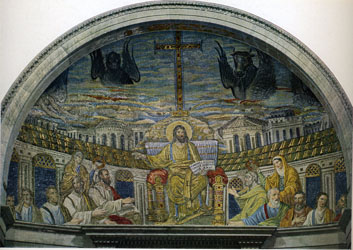
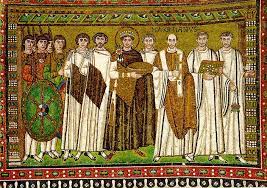
V. Islamic Civilization: an entirely non-Arab Phenomenon
When prophet Muhammad preached Islam among an uneducated, uncultured, barbaric, and marginal tribe, namely the Arabs of Hejaz, he raised the stakes exponentially. Suffice it that you read the (written by an anonymous Alexandrian Egyptian captain and merchant of the middle of the 1st c. CE) “Periplus of the Red (or Erythraean) Sea” (par. 20) and you understand how all the civilized nations of the wider region viewed the Arabs of Hejaz. With the acceptance of Islam by the Ancient Yemenites, who were a Semitic nation totally different from and unrelated to the Arabs of Hejaz, already two years before the death of prophet Muhammad (630 CE), an important change occurred: the majority of the followers of Islam were non-Arabs.
With the early Islamic invasions, many Aramaeans of Mesopotamia, Syria, and Palestine, many nations of the Sassanid Iranian Empire, many Copts (Egyptians), and many Berbers (from Libya and the African Atlas) accepted Islam, dramatically intensifying the fact that the Arabs constituted a minimal and unimportant part among the Muslims of the Omayyad and the Abbasid Caliphates. This generated a new socio-cultural environment from the Atlantic Ocean to the borders of China and the middle of the Subcontinent.
VI. Islamic Caliphate: Aramaean & Iranian Education, Sciences, Art, Culture, Intellectual life, and Spirituality under Arab rulers
The Islamic Civilization is an entirely non-Arab phenomenon, as it basically consists in an Aramaean & Iranian civilization with greatly diversified local traits. Within 150 years, after prophet Muhammad’s death, Aramaeans of Mesopotamia and Syria and Iranians transferred the corpus of the scientific, academic, intellectual, artistic and educational genius of the Sassanid Empire of Iran within the Islamic Caliphate.
In fact, Arabic is an Aramaean dialect written with Syriac Aramaic characters slightly deformed as cursive writing; without vocalization, almost the entire Quran can be read in Aramaic. So, Aramaeans (liberated from the yoke of the Eastern Roman Empire and unrestrained from the Constantinopolitan theological doctrine) and Iranian Mazdeists learned and used Arabic for the aforementioned purpose. In fact, the great Aramaean centers of learning, libraries and theological schools of Edessa of Osrhoene (Urfa), Nisibis (Nusaybin), Antioch (Antakya) and Seleucia-Ctesiphon (Al Mada’in) and the famous Sassanid Iranian imperial academy, university, research center, library and museum of Gundishapur, which was the world’s greatest center of learning and wisdom of the 6th c., were merged and continued in the legendary Bayt al Hikmah in Baghdad.



At the beginning, Islam appeared to be one more Christological heresy, eventually a more acute form of Nestorianism. With Late Antiquity Gnostics accepting Islam, it is not bizarre why Fathers of the Christian Church, like John Damascenus, a leading Aramaean scholar, poet, and theologian from Damascus, viewed Islam as a counterfeit version of Christianity. On the other hand, this fact explains fully why the Islamic Civilization was always (until its end in 1580) the realm of Learning and Education.

This fact has little to do with Quranic verses; it is mainly due to the constituent elements of the early Islamic society. When schools of faith and science, like that of the sagacious Ikhwan al-Safa (إخوان الصفا) created the dynamics they did, thanks to their mystical-intellectual endeavors, scientific explorations, and educational system, it would be impossible for the Islamic Civilization not to be at the antipodes of the Christian world: a domain of Learning.
VII. Islamic Spirituality, Religion and Culture vs. Governance and Theology
As spirituality was initially limited in the circle of the descendants (Ahl al Bayt) of prophet Muhammad, notably Ali ibn abi Taleb (who was the son-in law of prophet Muhammad and the prominent figure of the Ahl al Bayt), but governance was at the hands of the enemies of Ali ibn abi Taleb, a very strange situation arose. In the deeply and irreversibly divided (Omayyad and Abbasid) caliphate, education was soon controlled by the Aramaeans and the Iranians, whereas the military started being increasingly dominated by the incoming Turanian soldiers; at the same time, spirituality and religious orthodoxy and orthopraxy remained the exclusive domain of Ahl al Bayt, notably Ja’far al-Sadiq.
The caliphs wanted to justify their unjust and illegitimate rule, while various learners and pundits decided to make distinguished careers by justifying the unjustifiable; they were therefore hired by the caliphs and appointed as religious authorities in order to ‘explain’ as ‘Islamic’ the un-Islamic or anti-Islamic deeds of those caliphs. This attitude constituted an enormous schism between the spiritual endeavors of the early Islamic community and the religious practices of the disbelieving and unfaithful rulers, thus opening the path for a fake religion adapted to immoral, illegal and evil governance. This situation was utterly rejected by many spiritual mystics and erudite Muslims, and the ensuing polarization triggered an enormous literature of jurisprudential and theological contents. So, soon Islam started being turned from a religion to a theology.
VIII. The Secular Nature of the Islamic Society, Education, Culture and Civilization
Islam preaches a secular society, and for many hundreds of years the Islamic caliphates, sultanates, khanates and emirates were prominently secular of nature. The secular nature of Islamic education, spiritual and material research, literature, sciences, intellectual life, artistic inventiveness, and mysticism is underscored by the burgeoning character of the early Islamic society in which -for many long centuries- there was absolutely no ‘sunnah’ in the way this word is used nowadays by the ignorant ‘sheikhs’ and the uneducated ‘imams’ of Madinah, Istanbul, Mekkah, Al-Azhar, Qum, etc.
The fact that “there is no compulsion in religion” (Quran, chapter al-Baqara, verse 256) implied that Shariah law was not compulsory. Actually, there was no Shariah (in the sense this word is meant now) at all in the beginning, for the very simple reason that the historical prerequisite for Shariah is a school of Islamic jurisprudence. The Divine Law demanded from humans a ‘deep understanding’ (fiqh) of the Quran and the Hadith, and this is the real word for Islamic Law even today (as concept); to implement the Divine Law in the human society, the various jurisprudential schools accepted four sources: the Quran, the Hadith (prophet Muhammad’s sermons), qiyas (analogical reasoning),and ijma (juridical consensus). This automatically terminated Islam as religion, turning it to a theology.
The secular nature of the education in the Islamic caliphates and other kingdoms was the result of the well-diversified nature of the Islamic society, which incorporated many different cultures. Prophet Muhammad’s preaching was accepted differently in various locations in Asia, Africa and Europe, as it incorporated numerous diverse local cultures and traditions; this phenomenon generated a multitude of forms of worship, schools of spirituality and mystical tradition, and perceptions of (and approaches to) the spiritual and the material worlds, which were -all- called ‘Islamic’.
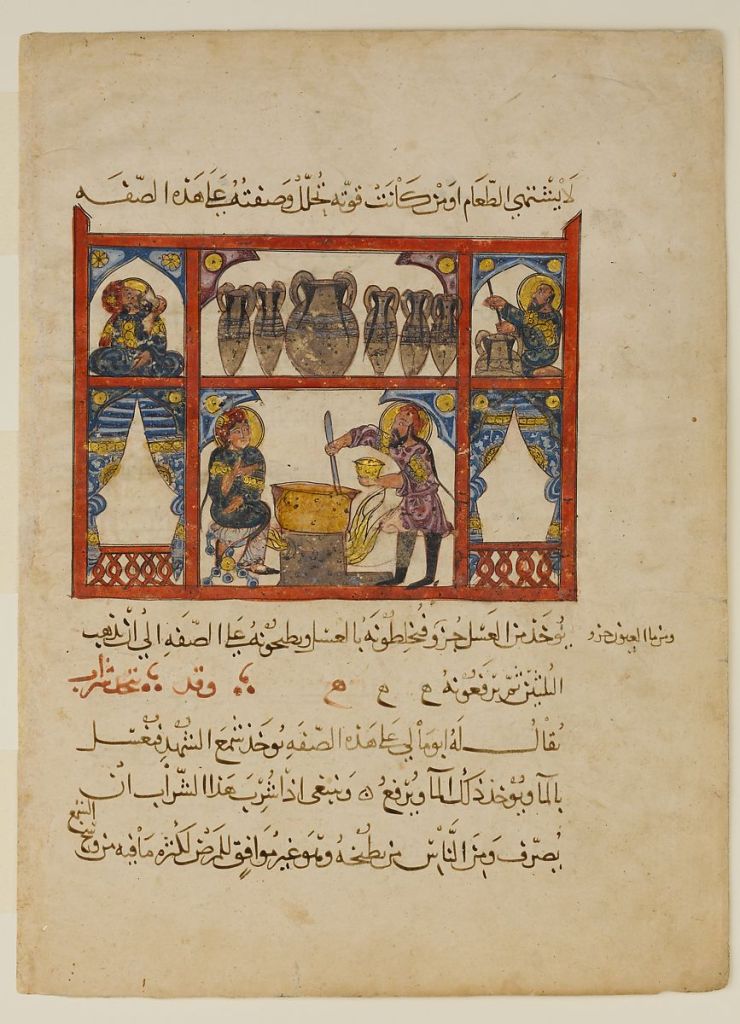


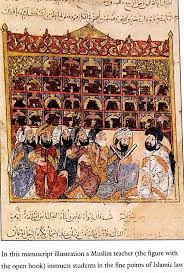
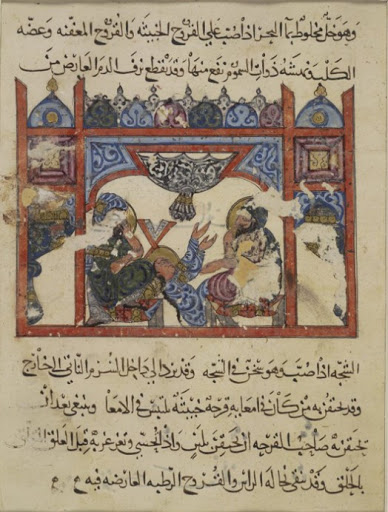


This dynamic spiritual, academic, intellectual, educational, socio-behavioral, and cultural process created an unprecedentedly decentralized phenomenon of faith, life, art, intellect and genius. It was the total opposite of the very centralized Christian churches, societies, states and educational systems. In fact, Islamic education, science and intellectual life reduced Islamic theology to small and marginal circles of dogmatic and indoctrinated imams, who could not impact the advance of Islamic Civilization and sciences.
Basically, Islamic education and culture were characterized by cohesion at the local level, only when viewed independently in the different parts of the Islamic world. However, in reality, an unprecedentedly wide number of different cults, positions, practices and beliefs could effectively be labeled ‘Islamic’, because for someone to be accepted as Muslim it is actually enough to confess that there is no god except God and that Muhammad is the messenger of God (which is the Shahada, i.e. the testimony, of faith / La ilaha illallah muhammadur rasulullah – لا إله إلا الله محمد رسول الله). Islamic education revolved around the basics of the religion, before orienting students toward the two main directions: spirituality and science.
IX. Islamic Education divided between Spirituality/Sciences/Arts and Theology
The only reactionary group of theologians, who wanted to limit education to the sphere of a dark, pseudo-Islamic theology, was the pseudo-school (madhhab) of Ahmed ibn Hanbal. However, this did not influence anyone and either in his days (mainly 9th c. CE) or later, it was not accepted as proper school of jurisprudence, but as a type of barbaric and ignorant heretics (Ahmed ibn Hanbal was also imprisoned). Notably, ibn Hanbal was rejected by Tabari, the Islamic world’s greatest historian and most erudite scholar of those days.
Only after the Crusades and due to the devastating impact that they had on the Muslims of the Eastern Mediterranean, a backward theological system demanded the end of Islamic sciences, the subordination of spirituality, genius and intellect to the villainous theological doctrine that these ignorant and idiotic people considered as ‘Islam’. This theological system is the baseless and anti-Islamic teaching of Ahmed ibn Taymiyyah, who was viewed as a heretic during his time and he was also imprisoned as impostor. His nonsensical theories ostensibly constitute a form of Christianization of Islam.
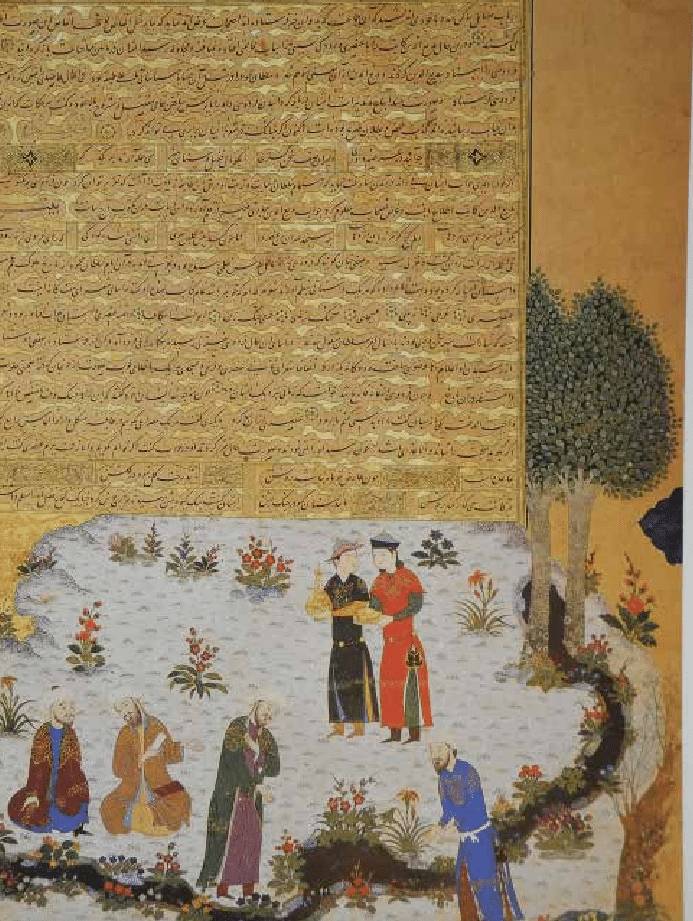


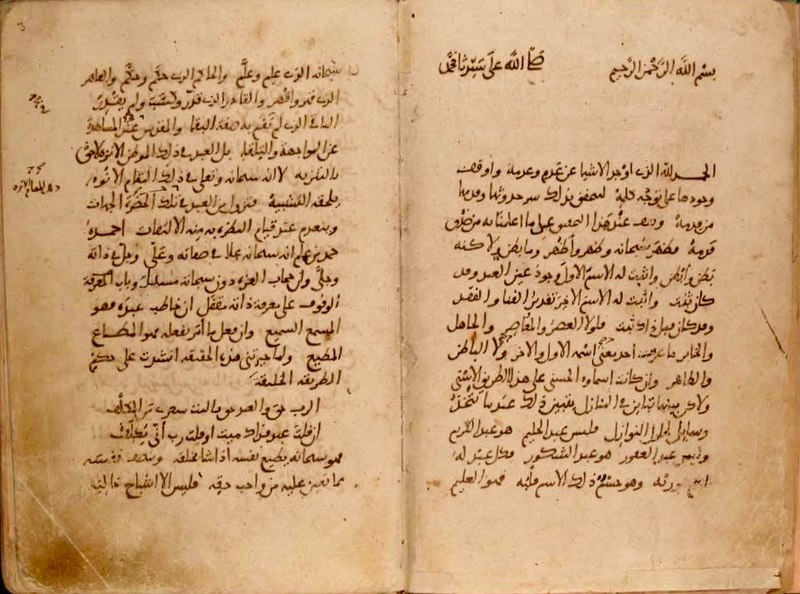





With the progression, the diffusion and the prevalence of this pathetic system, an enormous damage was caused to the Islamic Civilization; due to the erroneous education, which was impregnated by the evilness of Ahmed ibn Taymiyyah’s ideas, the Islamic sciences started being abandoned, the Islamic arts were disregarded or reduced to basic and meaningless forms, and the Islamic intellectual life was disintegrated. Even worse, Islamic spirituality was slandered as ‘black magic’, Islamic wisdom was obliterated and forgotten, and Islamic education was decreased to the level needed for imbeciles, who could not anymore comprehend the Quran in the way Muslims were able to understand their holy book two centuries earlier.
X. The divide between Islamic Spirituality/Sciences/Arts and pseudo-Islamic Theology disfigured as Shia vs. Sunni Schism
The reason for this development is the fact that Ahmed ibn Taymiyyah, following the line of Ahmed ibn Hanbal, preached that for Muslims’ education only theology mattered. This evil impostor generated a terrible divide between Islamic spirituality and theology, which lasted down to our days, but was mistakenly and viciously known as difference between ‘Shia’ and ‘Sunni’. However, this is an evil colonial lie and an Orientalist falsehood imposed on the colonial slaves of France, England and America, namely the ignorant sheikhs and pathetic imams of Islam.
In fact, there was never a historical division between ‘Shia’ and ‘Sunni’ throughout the History of Islam. The fake divide is an entirely modern, colonial fabrication, which was constructed, when ignorant and idiotic sheikhs, following the remote guidance and the evil orders of their Western masters, started presenting themselves as self-styled ‘Sunnis’. Western forgers and ignorant imams may today describe a historical war, let’s say the battle of Chaldiran (1514) between the Ottomans and the Safavid Iranians, as a fight between ‘Shia’ and ‘Sunni’, but this is entirely false.





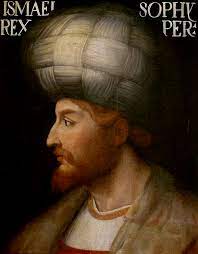
Neither Selim I nor Ismail Safavi, the Ottoman sultan and the Iranian shah, who exchanged written insults before the battle, called one another ‘Sunni’ and ‘Shia’. Neither was their difference a theological dispute. In reality, Selim I caused a terrible bloodshed (squelching the Shahqulu/Şahkulu movement) in order to impose a theological dogmatic tyranny in his pseudo-Islamic Ottoman realm, whereas Ismail Safavi established in Iran a secular education that allowed people to free pursue any walk of intellectual life that they wished, either in spirituality or in sciences, thus eliminating the tyranny of theological ignorance. The fact that these events are not portrayed in this manner in today’s educational systems of Turkey and Iran only shows how mistaken, misguided and self-disastrous these systems are. Of course, this is also true for the educational systems of all the other Muslim countries.
—————————————————
Download the text in Word doc:

Pingback: Renaissance, Colonialism, Anti-Christian Western European Politics, Fake Historicity, Political Nations and Historical Education – Part II | megalommatiscomments
Pingback: Ottoman Empire & Modern ‘Greece’, a Failed State with no Education & a Fake State with False Education: J. Ph. Fallmerayer, A. Korais and D. Byzantios – Part III | megalommatiscomments
Pingback: The 12 Pillars of Turkey’s National Education: Historical Identity, Cultural Integrity and Social Unity, instead of the Sectarian Political Islam – Part IV | megalommatiscomments